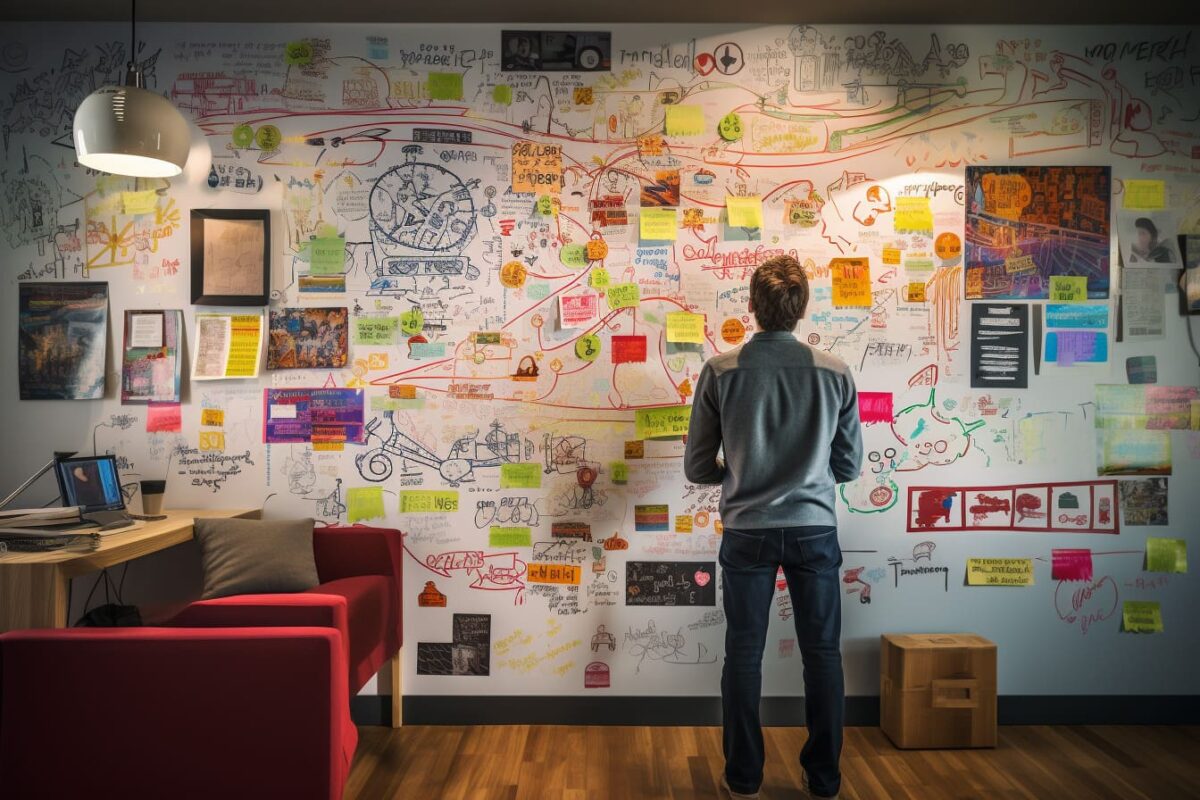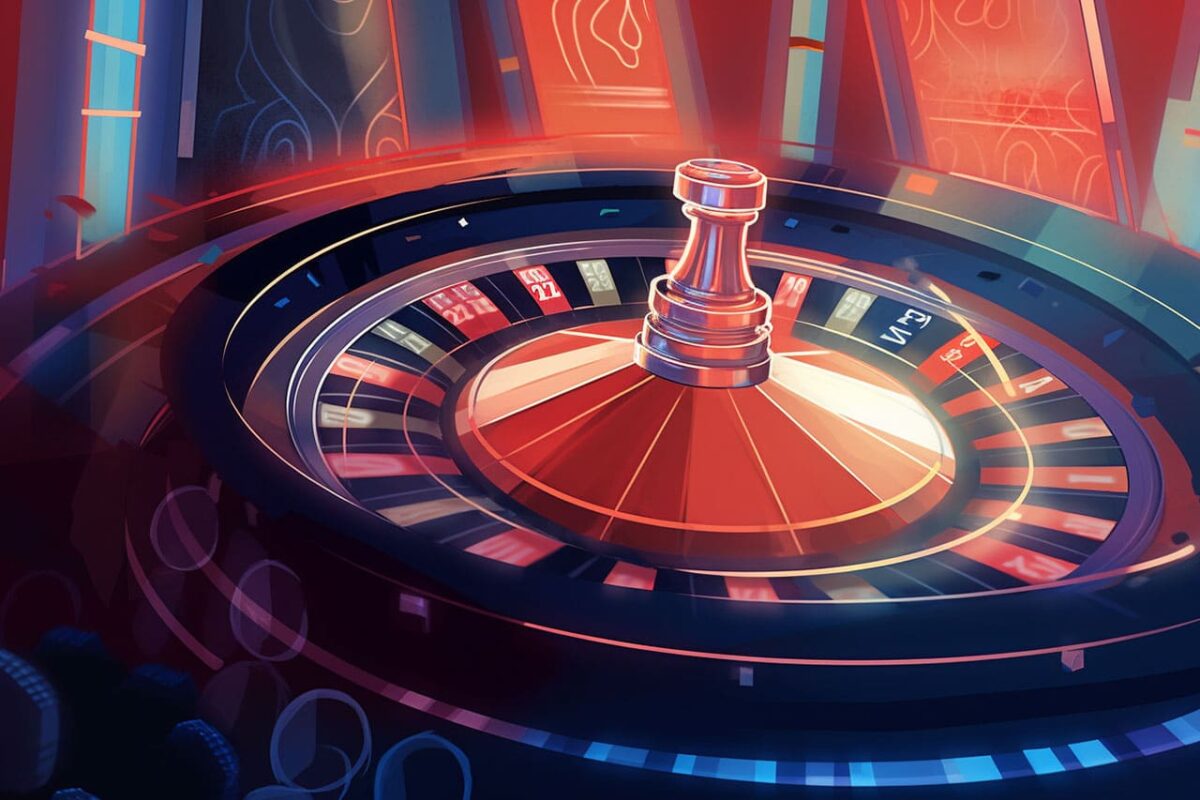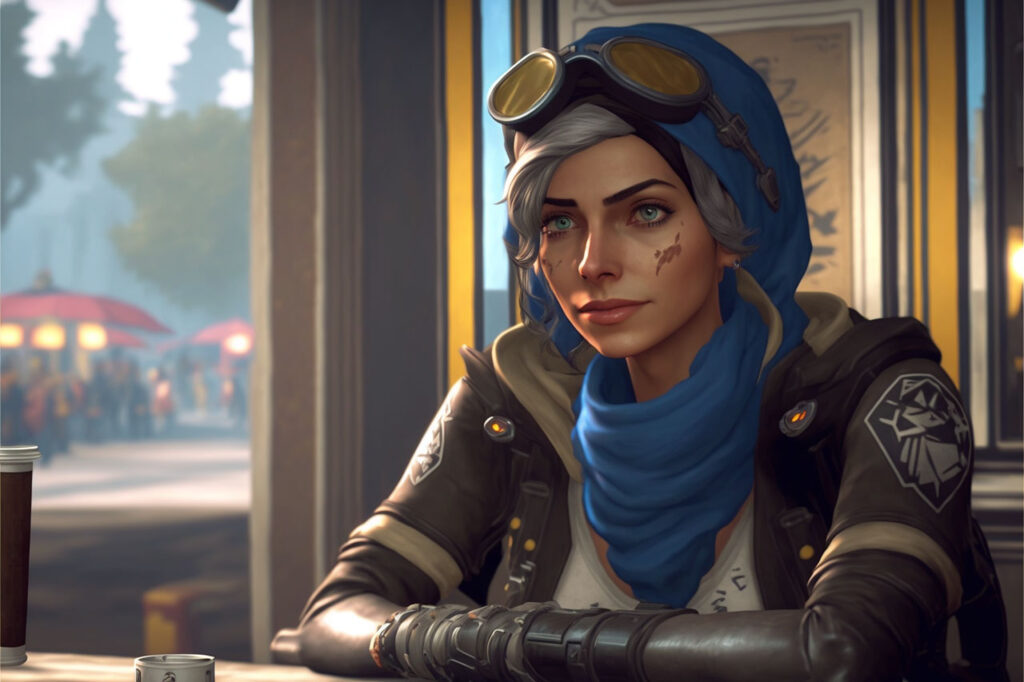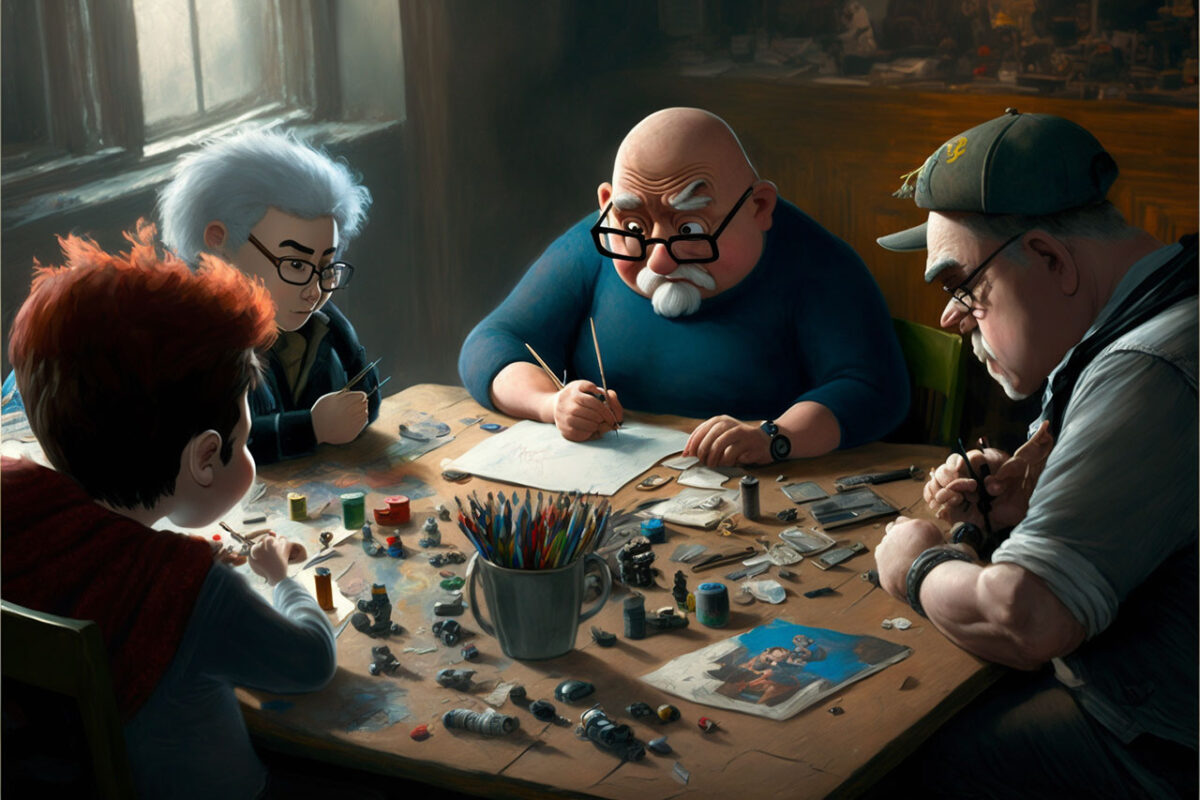Hey there, fellow creatives! If you’re reading this, chances are you’ve already dipped your toes into the wonderful world of Mind Mapping. It’s like the artist’s canvas for your thoughts, the writer’s notebook for your ideas, and the designer’s blueprint for your imagination. But what if I told you that we’re about to take your Mind Mapping game to a whole new level? Buckle up, because today we’re diving deep into the world of advanced Mind Mapping techniques, tailor-made for creative professionals like you.
Table of Contents
Introduction
Welcome to a journey of discovery and creativity. Mind Mapping isn’t just a tool; it’s a superpower that can unlock new dimensions of your creative potential. As someone who’s spent years in the creative trenches, I’ve come to understand the true magic of Mind Mapping. It’s not just about making pretty diagrams; it’s about harnessing the limitless power of your mind to tackle complex ideas, projects, and dreams.
The Foundation: Brief Recap of Basic Mind Mapping
Before we embark on this advanced Mind Mapping adventure, let’s touch base with the basics. If you’re new to Mind Mapping, don’t worry; we’ll keep it simple.
At its core, Mind Mapping is a visual representation of your thoughts and ideas. It starts with a central idea, often placed in the center of your page (or screen), and branches out into related concepts and sub-ideas. It’s like a tree with branches that reach out in all directions.
Here are a few key principles to remember:
- Use Keywords: Instead of full sentences, use keywords and short phrases to represent ideas. This keeps your Mind Map concise and easy to navigate.
- Radiant Structure: Branches radiate from the central idea, creating a structured yet flexible framework.
- Colors and Images: Get creative with colors and simple images to make your Mind Map visually appealing and memorable.
- Connect and Cross-Link: Connect related ideas using lines and arrows. Cross-linking helps you see relationships between different concepts.
That’s the foundation of Mind Mapping. If you’re already familiar with these basics, you’re ready to take the next step into the world of advanced Mind Mapping techniques. If not, take a moment to practice and play with these basics before we dive deeper.
In the next sections, we’ll explore how Mind Mapping can become your secret weapon for tackling complexity, boosting creativity, and unleashing your inner genius. So, grab your favorite mind-mapping tool, whether it’s a digital app or a trusty notebook, and let’s embark on this creative journey together.
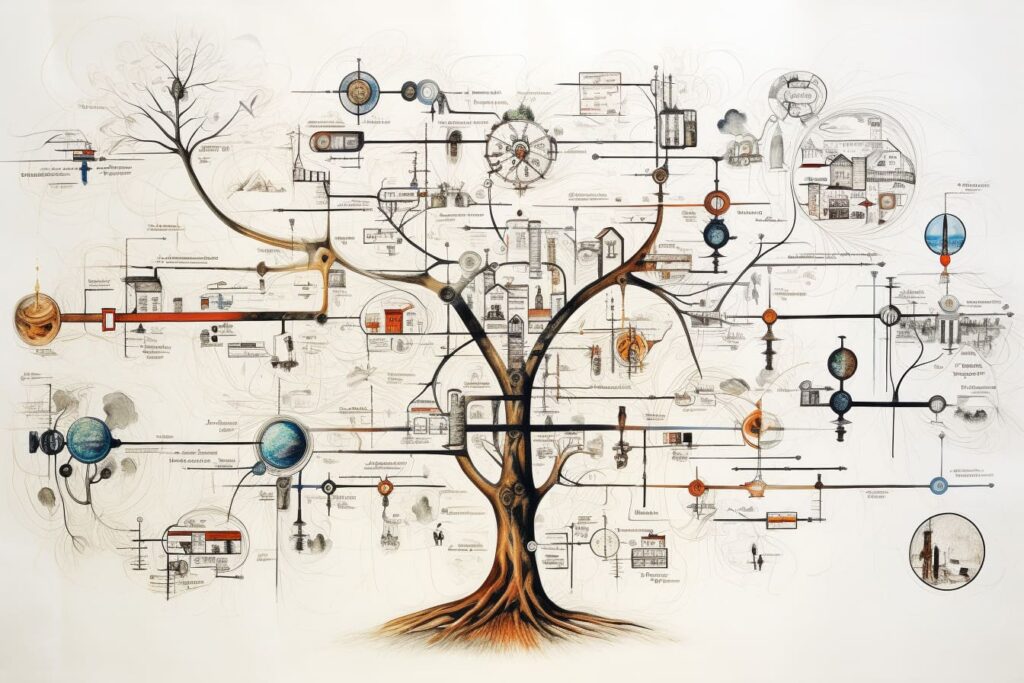
Navigating Complexity: Mind Mapping for Multifaceted Ideas
Now, let’s talk about the real game-changer: using Mind Mapping to navigate the labyrinth of complexity. As creative professionals, we often find ourselves grappling with ideas and projects that resemble intricate mazes. Here’s how advanced Mind Mapping can be your trusty guide:
Sub-Maps: Breaking Down the Complex
Think of Sub-Maps as Mind Maps within your Mind Map. When dealing with multifaceted concepts, creating Sub-Maps can help you break them down into manageable chunks. It’s like having a treasure map with multiple layers of clues. Each Sub-Map focuses on a specific aspect, allowing you to dive deeper while maintaining an organized overview.
Example: Imagine you’re planning a multimedia art project. Your main Mind Map may have branches for different mediums like painting, digital art, and sculpture. Create Sub-Maps for each medium to explore techniques, materials, and ideas in greater detail.
Hierarchical Structures: Organize with Precision
Sometimes, you need more than just branches to express the hierarchy of ideas. Hierarchical structures within your Mind Map allow you to organize ideas with varying levels of importance or detail. It’s like having a virtual filing system for your thoughts.
Example: Suppose you’re designing a new website. Your central idea is the website’s homepage. Use hierarchical structures to branch out into sections like navigation, content, and design. Within each section, further branching reveals sub-sections and details.
Color-Coding for Themes: Visual Clarity
Color-coding is a creative professional’s secret weapon. Assign different colors to different themes or categories within your Mind Map. This visual distinction helps you spot patterns and connections effortlessly. It’s like creating a visual roadmap to guide your creative journey.
Example: If you’re brainstorming ideas for a book, use colors to differentiate between plot, characters, settings, and themes. This not only makes your Mind Map visually engaging but also aids in organizing your thoughts by category.
Visual Creativity: Incorporating Art and Design into Mind Maps
As creative professionals, we have an innate flair for aesthetics. So why not infuse your Mind Maps with artistic elements? Here’s how you can turn your Mind Maps into visual masterpieces:
Illustrations and Doodles: Embrace Your Inner Artist
Add sketches, drawings, or doodles to represent ideas or concepts. This isn’t just about making your Mind Map visually appealing; it’s about engaging your right-brain creativity. Doodles can spark new insights and connections as you map out your thoughts.
Example: If you’re brainstorming ideas for a new logo design, incorporate quick sketches of potential logos directly into your Mind Map. It helps you visualize your concepts more vividly.
Icons and Symbols: Communicate with Visual Language
Use icons and symbols to convey meaning. Icons are like the emojis of Mind Mapping—they’re simple yet powerful. Whether it’s a lightbulb for ideas or a clock for deadlines, these visual cues enhance understanding and add depth to your Mind Map.
Example: In a project plan Mind Map, you can use icons like a handshake to represent collaboration, a gear for tasks, and a megaphone for communication. These icons provide instant context to your ideas.
Mind Map Templates: Start with Visual Structure
Not everyone is a born designer, and that’s perfectly fine. There’s a wealth of Mind Map templates available that offer visually appealing structures. Templates can kick-start your creative process, providing you with a solid visual foundation to build upon.
Example: When embarking on a complex project, explore project management Mind Map templates. These templates often include visual elements like timelines, progress bars, and milestones. Customize them to suit your creative style and project needs.
Beyond Linear Thinking: Mind Mapping for Lateral and Divergent Thinking
Creativity thrives on the ability to think beyond the obvious. Linear thinking might get you from point A to point B, but lateral and divergent thinking open up entirely new horizons. As creative professionals, it’s crucial to embrace these modes of thought, and Mind Mapping is your trusty companion in this endeavor.
Lateral Thinking: Connecting the Unconnected
Lateral thinking is all about making unexpected connections. It’s about seeing relationships between seemingly unrelated ideas. Mind Mapping encourages lateral thinking by its very nature—those branches reaching out can lead you down unexpected but delightful paths.
Example: Say you’re working on a marketing campaign for a new eco-friendly product. Mind Mapping can help you connect concepts from nature, technology, and consumer behavior. These connections might lead to innovative campaign ideas that resonate with your audience.
Divergent Thinking: Generating Creative Options
Divergent thinking is the art of generating a multitude of creative solutions. Mind Mapping is a powerful tool for divergent thinking because it allows you to brainstorm freely and capture every idea that pops into your head. It’s like having a brainstorming session with yourself.
Example: If you’re a writer stuck in a creative rut, use Mind Mapping to brainstorm potential plot twists, character arcs, or story settings. Write down every idea, no matter how wild, and see where your creativity takes you.
Collaboration and Brainstorming: Mind Mapping in Creative Teams
Creativity is often a collaborative effort. Whether you’re working with a team of designers, writers, or fellow creatives, Mind Mapping can be the glue that binds your collective genius. Let’s explore how Mind Mapping fosters collaboration and fuels brainstorming sessions:
Team Mind Maps: A Shared Visual Canvas
Imagine a virtual whiteboard where every team member can contribute their ideas visually. Team Mind Maps provide precisely that. Each member can add branches, notes, and visuals in real-time, creating a shared visual canvas for brainstorming.
Example: In a design team, you can create a Team Mind Map for a new project. Designers can sketch ideas, copywriters can add text snippets, and project managers can outline deadlines—all on the same Mind Map.
Structured Brainstorming: Guided Creativity
Traditional brainstorming sessions can sometimes feel chaotic. Mind Mapping adds structure to the process. Start with a central idea, set a specific goal, and let team members branch out with their contributions. It ensures that brainstorming remains focused and productive.
Example: During a content brainstorming session, set the central idea as “Holiday Campaign.” Team members can then create branches for different aspects like “Social Media Posts,” “Email Newsletter,” and “Blog Articles,” making it easy to see the big picture.
Remote Collaboration: Bridging the Distance
In today’s world, collaboration often happens across geographical boundaries. Mind Mapping tools with real-time collaboration features allow creative teams to work seamlessly, no matter where they are. It’s like having a virtual brainstorming room.
Example: A design agency with team members in different cities can use online Mind Mapping tools to collaborate on a client’s project. Designers can share their visual ideas, and project managers can provide feedback in real-time.
Time Management: Mind Mapping for Project Planning and Execution
In the fast-paced world of creativity, time is often a precious commodity. Advanced Mind Mapping techniques can become your time management allies, helping you plan and execute projects with finesse. Let’s explore how Mind Mapping can be your secret weapon for effective project management:
Project Mind Maps: From Concept to Completion
Project Mind Maps are your roadmap to success. Start by mapping out the entire project, from conceptualization to completion. Break down the project into phases, tasks, and milestones, creating a visual representation of your project’s journey.
Example: If you’re a filmmaker, create a Project Mind Map for your upcoming movie. Each branch can represent different stages like scriptwriting, casting, filming, editing, and promotion. Attach deadlines and resources to keep everything on track.
Task Lists and Progress Tracking: Stay on Target
Mind Mapping tools often include task management features. Use these to create task lists within your Mind Map. Assign responsibilities, set deadlines, and track progress. It’s like having a project management tool integrated into your creative process.
Example: In a content creation project, you can list individual tasks like research, writing, editing, and publishing within your Mind Map. Assign team members to each task and update the progress as you go.
Visual Timelines: See Time Unfold
Visual timelines within your Mind Map provide a clear overview of your project’s schedule. You can create timelines for specific project phases or the entire project. Visualizing time helps you allocate resources efficiently and meet deadlines.
Example: A graphic designer working on a website redesign can use a visual timeline within their Mind Map to plot out key milestones like wireframing, design drafts, and testing phases, ensuring a smooth workflow.
Mind Mapping Software: Tools to Elevate Your Creativity
Now that you’re armed with a deeper understanding of advanced Mind Mapping techniques, let’s talk about the tools that can take your creativity to the next level. As a creative professional, your choice of Mind Mapping software can significantly impact your workflow. Here, I recommend Mind Mapping software and tools tailored to unleash your creative genius:
1. MindMeister
- Collaborative Genius: MindMeister excels in collaborative Mind Mapping. It allows multiple users to brainstorm in real-time, making it perfect for creative teams.
- Integration Superpowers: Seamlessly integrate with other productivity tools like Trello and Google Drive to streamline your creative projects.
2. XMind
- Creative Templates: XMind offers a range of creative templates that can jumpstart your Mind Mapping process. From concept maps to flowcharts, it’s a creative toolbox.
- Gantt Chart View: Visualize project timelines and deadlines with the Gantt Chart view, ideal for tracking creative project progress.
3. Coggle
- Flowcharts and Diagrams: If your creative work involves flowcharts and diagrams, Coggle is your go-to choice. It simplifies complex ideas.
- Real-time Collaboration: Like a virtual whiteboard, Coggle enables real-time collaboration with colleagues or clients for creative brainstorming.
4. iMindQ
- Visual Mind Mapping: iMindQ emphasizes visual Mind Mapping with a rich library of templates, icons, and graphics to make your Mind Maps visually stunning.
- Project Management Integration: Seamlessly integrate Mind Maps with project management tools like Microsoft Project for creative project planning.
Remember, the choice of Mind Mapping software ultimately depends on your specific creative needs and preferences. Experiment with these tools to find the one that resonates with your creative process.
Angel’s Tips and Insights
Now, let me share some personal tips and insights that I’ve gathered along my journey as a creative professional who’s dived headfirst into the world of advanced Mind Mapping. These nuggets of wisdom are the result of trial and error, moments of inspiration, and countless Mind Maps. I hope they resonate with you and add a personal touch to your own creative journey:
- Embrace Messy Mind Maps: Don’t be afraid of Mind Maps that look like an explosion of ideas. The messier, the better. Your creativity thrives in chaos, and you can always tidy things up later.
- Mind Map Your Dreams: Literally. Create Mind Maps of your dreams, aspirations, and wild ideas. You’ll be amazed at how Mind Mapping can turn dreams into actionable plans.
- Mind Map with Kai: My Siberian Husky, Kai, is my silent brainstorming buddy. Sometimes, the best Mind Maps happen during our long walks. Creativity loves a breath of fresh air.
- Mind Mapping Rituals: Develop your Mind Mapping rituals. Maybe it’s a specific playlist, a favorite pen, or a cozy corner of your workspace. These rituals can trigger your creative flow.
- Mind Map Your Progress: Regularly Mind Map your creative journey. It’s a fantastic way to reflect on your growth, celebrate your successes, and set new creative goals.
Conclusion
In the grand tapestry of creativity and productivity, advanced Mind Mapping is your trusted thread. It weaves together your ideas, your dreams, and your potential into a beautiful and organized masterpiece. As we wrap up this exploration, let’s summarize what we’ve learned:
- Advanced Mind Mapping techniques are your gateway to navigating complexity, boosting lateral and divergent thinking, and mastering time management in your creative endeavors.
- Collaborative Mind Maps foster teamwork, making creativity a shared experience that transcends physical boundaries.
- The right Mind Mapping software can elevate your creative process, offering features that align with your unique creative needs.
- Personal insights and tips, like those shared in this article, add a touch of humanity and authenticity to your Mind Mapping journey.
So, my fellow creatives, I encourage you to embrace advanced Mind Mapping techniques with open arms and open minds. Let it be the catalyst for your creative evolution. Let it be your trusted companion in the pursuit of limitless creativity and boundless productivity. Your imagination knows no bounds, and with Mind Mapping, neither do you.
Cheers to your creative journey, and may your Mind Maps be the keys to unlocking your full creative potential!
